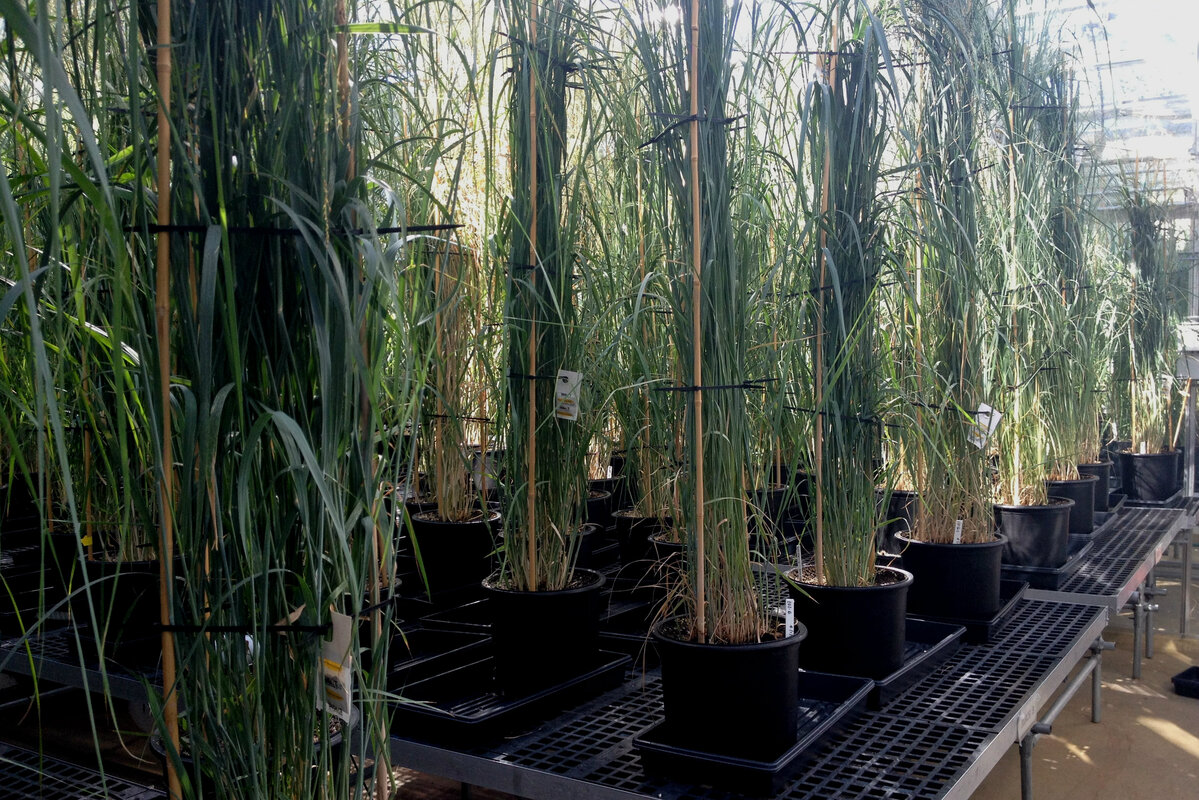What if plants could be plastic factories?
Loading...
| Cambridge, Mass.
The greenhouse at Metabolix’s lab is full of grass. That would be unexciting, except that the 300 or so pots of switchgrass growing here have been genetically engineered to produce a kind of polymer used to make plastics.
Metabolix, a bioplastics company founded in 1992, is one of a small group of companies and universities pushing at a new frontier in bioplastics: the genetic engineering of crops to produce plastics materials. The efforts – unique in making bioplastics not from, but in, crops – put forward a solution to the longstanding problem in bioplastics: how to make the production costs of bioplastics as cheap as, or cheaper than, oil-based plastics.
The answer, these scientists say, is in plants: What if crops, planted in droves in US farm fields, could become quiet, tiny plastics factories, churning out all the plastics we need?
But that, of course, raises another question: Is that even possible?
Bioplastics, simply put, are plastics made from renewable biomass resources as opposed to fossil fuels. Billed as a potentially cheaper and more sustainable alternative to conventional oil-produced plastics, bioplastics is a fledgling industry, and, so far, both eco-friendliness and cheapness have not been achieved in one product.
At the moment, bioplastics are often made from corn, a controversial wing of the industry, as studies have found that the fallout from the chemical use that goes into growing the corn outweighs the potential environmental benefits of using corn-based plastic. Other means of producing bioplastics, such as using bacteria to ferment sugars into polymers, remain more expensive than using fossil fuels, given the vast industrial infrastructure that supports conventional plastics-making.
In short, the big problem in bioplastics is much the same as it is throughout the entire bioindustrial field: eco-friendly, in the short term at least, is not cheap.
“It all comes down to a bottom line: Bioplastics won't ever be competitive with petro-chemical plastics if their cost is higher,” said Stevens Brumbley, a professor of molecular biology at the University of North Texas whose team works with sugar cane-derived plastics and shares funds and findings with Metabolix.
In 2001, Metabolix bought GMO giant Monsanto’s decade of research on using plants to make plastics. That year, the company began tinkering with the genome of switchgrass – a grass that Oliver Peoples, a former researcher at the Massachusetts Institute of Technology and the founder of Metabolix, says meets all the conditions for it to be deployed toward plastics production. Switchgrass is a perennial crop with a high tolerance for erratic weather, it has a high biomass and, for the moment, it does not contribute to the human food supply, meaning that it won’t be missed if fields of it are marshaled toward plastics-making.
“It just fundamentally makes sense,” said Dr. Peoples. “What’s the most abundant source of carbon? Carbon dioxide. What are the most efficient fixers of carbon dioxide? Plants.”
But what is simple in theory is, it turns out, difficult in practice. Plants are good at turning carbon dioxide into sugar, not into compounds for plastics.
So turning the plant into a small plastics manufacturer requires some high-tech genetic engineering. That begins with modifying switchblade grass cells to have three genes that produce a compound called polyhydroxybutyrate, or PHB. Those genes are borrowed from the soil-based bacteria that are at the moment used to produce much of the PHB used in bioplastics engineering.
"In this field, being called crazy is a compliment,” said Maria Somleva, a researcher at Metabolix, as she held a warm petri dish dotted with cell cultures modified to, well, behave a bit like bacteria.
After a few weeks, those cells begin to grow a tiny, pinprick-sized sprout of green: a new plant. Once big enough, the plants are bagged and transferred to the lab’s greenhouse to be potted. There, they’ll grow into tall, pale green grass with seed-laced fibers dangling elegantly from the tips, producing in their thin stalks not just glucose but PHB.
But while these modified plants do produce PHB, they don’t produce enough of it. Metabolix’s switchgrass plants are making PHB in a quantity of about 2 percent of their body weight. For switchgrass to be profitable as a plastics producer, that number will have to be about 10 percent. That means Metabolix is still waiting for an 8 percent increase in PHB production, a big leap in relative terms.
To address that gap, scientists there turned about 18 months ago to photosynthesis. The hope is that engineering the plants to overexpress the genes controlling photosynthesis will encourage the plants to produce more PHB – essentially, scientists at Metabolix want plants to believe that “2+2=5,” as Peoples puts it. So far, the plants are growing faster and higher, but it’s unknown if that growth is translating into more PHB, he said.
Metabolix has already had some success in getting tobacco plants to produce substantial amounts of PHB – about 9 percent of that plant’s body mass. Though turning a major cash crop like a tobacco plant into plastic is not an economically attractive option, that earlier success with tobacco plants heralds eventual good news with switchblade grass, Peoples said.
“We know that plants are capable of doing this,” said Peoples. “It’s not going to be easy, but there is a way.”
Still, the challenges in turning plants into plastics producers go beyond engineering the plants to produce enough PHB.
“The technology hurdles are so large here,” said Richard Gross, a professor of biomolecular engineering at the Rensselaer Polytechnic Institute and the founder of SyntheZyme, a major innovator in bio-based plastics.
Once switchgrass makes enough PHB to be economically viable, the next challenge will be to repeat that production out of the greenhouse and in the fields. Then comes the still unsolved challenge of extracting that PHB efficiently and at a low cost, he said.
“If you’re doing this large scale, you’re not doing this in a controlled environment anymore,” Dr. Gross said.
Those cautions are familiar to the scientists pursuing plant factories.
“A lot of people are doubtful that we can make plastics in plants and get them to a quality and uniformity that would satisfy the manufacturing sector,” said Dr. Brumbley. “We don’t know these plants will perform in the field. We’re asking a biological system to, under varying conditions, produce the exact same thing every time.”
And even when the sugar cane is in the ground and spinning polymers in its leaves, Brumbley says he expects to hit another roadblock: GMO opposition.
“It will be hard for the sugar industry to adopt this technology and still sell its sugar to the market,” he said, noting that his team has already begun the process of filing for exemption status in both Australia and the United States, which would insulate sugar produced in plants modified to also make plastics from GMO labeling. He expects that process to take about a decade.
And how long until plastics made in sugar cane are market ready?
“I’ve been saying 15 years for about 15 years,” he said. “But I think we’re close now.”
And for Brumbley, "close" is a powerful word, after watching what was just a fantastic hypothetical turn into – accidentally – something real. In 1998, after returning home to Australia from a sugar cane genomics conference in Brazil, where researchers were first beginning to genetically engineer bacteria to use sucrose, not glucose, to make a polymer, Brumbley received a phone call from a Reuters employee. Was Brumbley doing similar work in Australia? the reporter wanted to know.
Brumbley said he wasn’t.
“Well, what work would you want to do in Australia?” the reporter asked.
Brumbley said it would be interesting if he could engineer plants to make plastics. The reporter reported that Brumbley was engineering plants to make plastics. After that misquote ran, the calls from big chemical companies came in. Brumbley began tinkering with sugar cane’s genome. Fantasy became fact.
“All this came from one misquote from a reporter,” said Brumbley.





